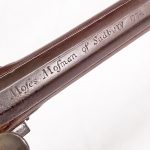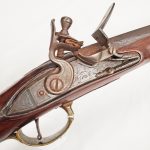
A few weeks ago, I talked about gun making at the outbreak of the American Revolution. Recently I picked up a fowling piece that is a prime example of gun making around the start of the war. I had seen this gun in the 1990s and had forgotten about it till I received a call from the daughter of the previous owner that it was time to go to a new home. I eagerly ran over to pick it up.
 The gun is a wonderful small game or fowling piece. It is small in stature and caliber having a .52 bore, a barrel length of 40”, and an overall length of 56”. It has a cherry stock with a French-style butt with a Roman nose, raised carving around the barrel tang, lock, and side plate. The butt plate, side plate, trigger guard, and ramrod pipes are brass. The lock has a stepped tail, and the lock plate is marked “M/Mosman.” The best part is the marking on the top of the barrel, “Moses Mosman of Sudbury 1774.”
The gun is a wonderful small game or fowling piece. It is small in stature and caliber having a .52 bore, a barrel length of 40”, and an overall length of 56”. It has a cherry stock with a French-style butt with a Roman nose, raised carving around the barrel tang, lock, and side plate. The butt plate, side plate, trigger guard, and ramrod pipes are brass. The lock has a stepped tail, and the lock plate is marked “M/Mosman.” The best part is the marking on the top of the barrel, “Moses Mosman of Sudbury 1774.”
Dr. Moses Mosman was born in Sudbury, Massachusetts on February 22, 1742. While he was a doctor in town, he also built and repaired guns. A bill in the Town of Sudbury records book states that on October 3, 1774, Mosman was paid 1 pound 12 shillings for 9 days working on the town’s guns to prepare them for the militia as things heated up between the British and Provincials. He was married on April 2, 1775, to Mary Willard in Lancaster, Massachusetts, just days before the outbreak of the Revolutionary War and they had 5 children, the last being his son James, born January 1, 1782. In 1816, Moses wrote his will, and it states, “I give and bequeath into my beloved son James Mofman/my little gun and all the equipments thereunto belonging.” He also left James his “tools for gunwork.” On August 16, 1817, Moses died of ulceration of the urethra at 75 years old. The next day, his wife Mary died at 66 “by her own hands.” Son James died young in 1819 at 37 years old, and in his 1820 probate is listed a fowling piece that was sold to a J. Jones, as well as horns and bullet molds. This may be the gun he had received from his father in 1817 after his passing.
This gun has a wonderful history and research has enabled us to put his story together. But Mosman didn’t make the lock of the gun or the barrel. They were purchased at a retailer, and he stocked or assembled the gun. While he didn’t make all the parts himself, the assembly process is still a lot of work and requires fine skills. It is obvious looking at this fine piece that Doctor Mosman had those skills.




